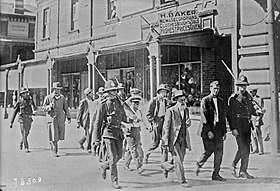| Rand Rebellion | |||||||
|---|---|---|---|---|---|---|---|
| Part of the Revolutions of 1917–1923 | |||||||
 Rebels being taken prisoner in Fordsburg | |||||||
| |||||||
| Belligerents | |||||||
|
|
| ||||||
| Commanders and leaders | |||||||
|
|
| ||||||
| Casualties and losses | |||||||
|
~200 killed[1] 4 executed | |||||||
The Rand Rebellion (Afrikaans: Rand-rebellie; also known as the 1922 strike) was an armed uprising of white miners in the Witwatersrand region of South Africa, in March 1922. Jimmy Green, a prominent politician in the Labour Party, was one of the leaders of the strike.
Following a drop in the world price of gold from 130 shillings (£6 10s) per fine troy ounce in 1919 to 95s/oz (£4 15s) in December 1921, the companies tried to cut their operating costs by decreasing wages, and by weakening the colour bar by promoting cheaper black mine workers to skilled and supervisory positions.[2]
- ^ Bendix, S. (2001). Industrial relations in South Africa. Claremont: Juta. p. 59. ISBN 978-0-7021-5279-5.
- ^ "Fifty fighting years – chapter 3". sacp.org.za.